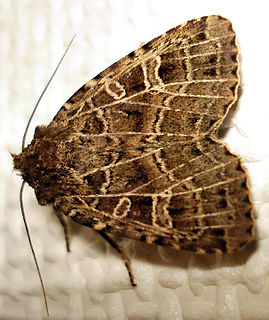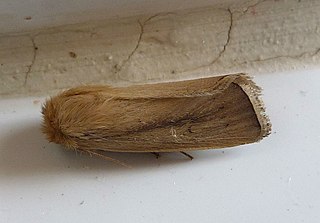
The Noctuidae, commonly known as owlet moths, cutworms or armyworms, are the most controversial family in the superfamily Noctuoidea because many of the clades are constantly changing, along with the other families of the Noctuoidea. It was considered the largest family in Lepidoptera for a long time, but after regrouping Lymantriinae, Catocalinae and Calpinae within the family Erebidae, the latter holds this title now. Currently, Noctuidae is the second largest family in Noctuoidea, with about 1,089 genera and 11,772 species. However, this classification is still contingent, as more changes continue to appear between Noctuidae and Erebidae.

The Gothic is a moth of the family Noctuidae. The species was first described by Carl Linnaeus in his 1758 10th edition of Systema Naturae. It is distributed in temperate Eurasia, in the Palearctic realm, including Europe, Turkey, Iran, Caucasus, Armenia, Transcaucasia, Central Asia, Altai mountains, and west and central Siberia.

The Noctuinae are a subfamily of the family Noctuidae. The larvae of many species feed on roots or stems of various grasses. Some are generalist feeders which makes them potential pests.

Phalaena is an obsolete genus of Lepidoptera used by Carl Linnaeus to house most moths.

Drasteria is a genus of moths in the family Erebidae.

Drasteria cailino is a moth of the family Erebidae first described by Alexandre Louis Lefèbvre de Cérisy in 1827. It is found in southern Europe, the Near East and Middle East up to the western Himalayas in the east. In the Levant, several isolated populations are present in Lebanon, Syria and Israel.

Leucania loreyi, the cosmopolitan, false army worm or nightfeeding rice armyworm, is a moth of the family Noctuidae. It is found in most of African countries, the Indo-Australian subtropics and tropics of India, Sri Lanka, Myanmar, the eastern Palearctic realm, and the Near East and Middle East. The species was first described by Philogène Auguste Joseph Duponchel in 1827.

The Erebidae are a family of moths in the superfamily Noctuoidea. The family is among the largest families of moths by species count and contains a wide variety of well-known macromoth groups. The family includes the underwings (Catocala); litter moths (Herminiinae); tiger, lichen, and wasp moths (Arctiinae); tussock moths (Lymantriinae), including the arctic woolly bear moth ; piercing moths ; micronoctuoid moths (Micronoctuini); snout moths (Hypeninae); and zales, though many of these common names can also refer to moths outside the Erebidae. Some of the erebid moths are called owlets.

Sesamia nonagrioides, the Mediterranean corn borer, pink stalk borer or West African pink borer, is a moth of the family Noctuidae. It was described by Alexandre Louis Lefèbvre de Cérisy in 1827. It is found in Spain, southern France, Italy and on the Balkan Peninsula, as well as in north-western, south-western and western Africa.
Pseudocharis naenia is a moth in the subfamily Arctiinae. It was described by Herbert Druce in 1884. It is found in Guatemala.
Noctuini is a tribe of owlet moths in the family Noctuidae. There are at least 520 described species in Noctuini.








